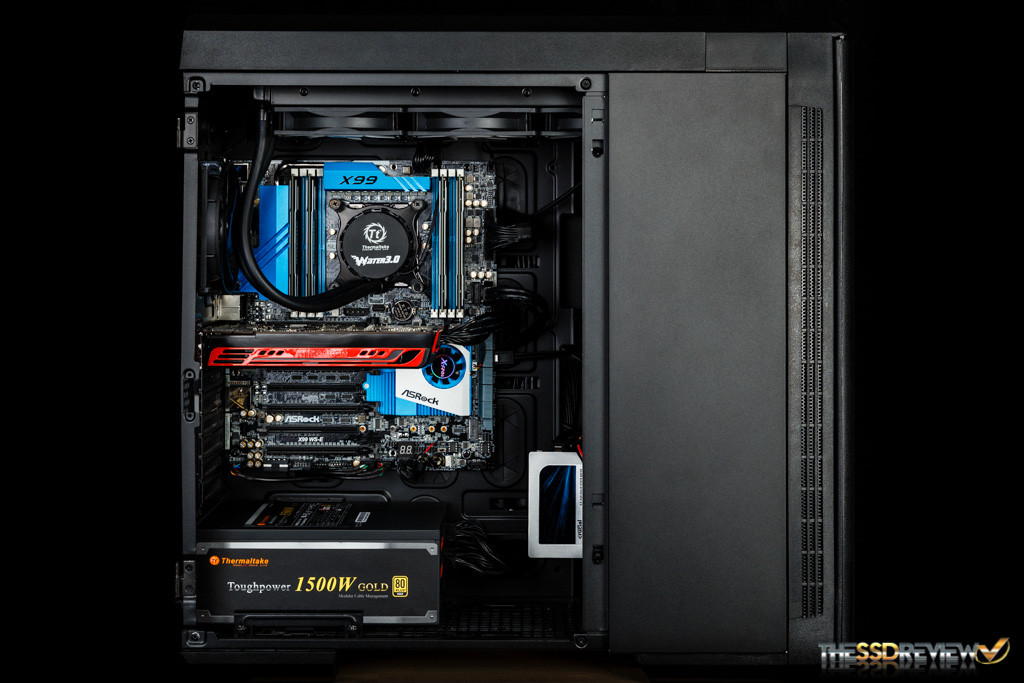TEST SETUP AND METHODOLOGY
In testing all enterprise drives we focus on long-term stability. In doing so, we stress products not only to their maximum rates, but also with workloads suited to enterprise environments. We use many off-the-shelf tests to determine performance, but we also have specialized tests to explore specific behaviors we encounter. With enterprise drives, you will see that we do not focus on many consumer-level use-cases.
When testing SSDs, the drive is purged and then preconditioned into a steady state before capturing its performance results. We also disable all write caching on the DUT when possible, this ensures consistent results that are compliant with SNIA standards. Our hope is that we present tangible results that provide relevant information to the buying public.
SYSTEM COMPONENTS
| PC CHASSIS: | Thermaltake Urban T81 |
| MOTHERBOARD: | ASRock X99 WS-E |
| CPU: | Intel Xeon E5-2690 v3 |
| CPU COOLER: | Thermaltake Water 3.0 Ultimate |
| POWER SUPPLY: | Thermaltake Toughpower 1500W Gold |
| GRAPHICS: | MSI GT 720 |
| SYSTEM COOLING: | be quiet! Silent Wings 2 |
| MEMORY: | Kingston ValueRAM DDR4 2400MHz ECC 64GB |
| STORAGE: | Crucial MX200 500GB |
| OS: | Windows Server 2012 R2 |
| MOBO FIRMWARE: | 1.70 |
This Test Bench build was the result of some great relationships and purchase; our appreciation goes to those who jumped in specifically to help the cause. Key contributors to this build are our friends at ASRock for the motherboard and CPU, be quiet! for the cooling fans, and Thermaltake for the case. We have detailed all components in the table below and they are all linked should you wish to make a duplicate of our system as so many seem to do, or check out the price of any single component. As always, we appreciate your support in any purchase through our links!
CRYSTAL DISK INFO VER. 7.0.5
Crystal Disk Info is a great tool for displaying the characteristics and health of storage devices. It displays everything from temperatures, the number of hours the device has been powered, and even to the extent of informing you of the firmware of the device.
CDI does a great job of displaying as many logical devices from the two DCP1000 drives as it can, remembering, of course, there are four logical drives for each, totaling eight. Looking at SMART ID’s 6-9 also gives us a great indication of just how much testing these drives have seen.
ATTO Disk Benchmark is perhaps one of the oldest benchmarks going and is definitely the main staple for manufacturer performance specifications. ATTO uses RAW or compressible data and, for our benchmarks, we use a set length of 256MB and test both the read and write performance of various transfer sizes ranging from 0.5 to 64MB. Manufacturers prefer this method of testing as it deals with raw (compressible) data rather than random (includes incompressible data) which, although more realistic, results in lower performance results.
14GB/s read and 13GB/s write is incredible…even when being seen through such a consumer-centric program as ATTO. We were surprised the software even held up at speeds this fast.
 The SSD Review The Worlds Dedicated SSD Education and Review Resource |
The SSD Review The Worlds Dedicated SSD Education and Review Resource | 


this is insane…. @intel shame on your optane!
“we use a set length of 256mb” sb 256MB “and test both the read and write performance of various transfer sizes ranging from 0.5 to 8192kb.” sb 8192kB.
Is it possible to boot from this RAID?
No. The only way to boot from this device is to use a single drive as the boot drive and the remaining three in RAID; the speed of which is very similar to these tests.
not even with Intel VROC or this “WS C621E SAGE
“Motherboard?
VROC doesn’t work and, unless you can find a way to get a UEFI to recognize the RAID, it simply can’t be done. That feature is not part of the drive, where it may be with others. Any of the individual four SSDs can boot from that drive when not in RAID mode.